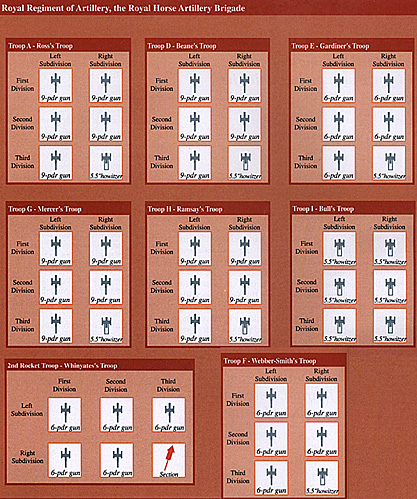As part of the Royal Regiment of Artillery, the Royal Horse Artillery Brigade (commonly referred to as the Royal Horse Artillery or RHA) comprised seven tactical combat units by 1801, rising in number to twelve by 1806. Each such unit was called a troop (equivalent to a foot artillery battery) and was lettered A through M, J being omitted. On campaign, in official reports and news accounts the troop was almost always referred to by its commander's name. For example, G Troop is better known as Mercer's Troop.
In RHA troops all the officers and men were mounted on horses or rode on the gun limbers or wagons (called caissons). In a foot battery, while the guns and wagons were pulled by horses as with the RHA, only the officers were mounted; gunners and enlisted men traveled by foot.
A troop was comprised of three "divisions" with a subdivision containing a single gun, its crew and ammunition wagon. Each division was led by a lieutenant, each right subdivision by a sergeant, and the left one by a corporal. The troop could also be split into two "half-brigades" of three subdivisions each, one half officered by the troop captain, the other half by the troop's second captain.
As a rule, each horse artillery troop (as was the case with the foot batteries) was assigned to an infantry division. These pairings became a permanent fixture during the Peninsular War, so much so that it was extremely difficult to pry a troop away from its division even in an emergency during a battle!
A troop was authorized 168 officers and enlisted men if it was armed with 6-pounder guns (6-pounder, referring to the weight of the cannon ball fired), or 200 total personnel if equipped with 9-pounders. Horses and mules authorized were 182 for a 6-pounder battery and 194 for a 9-pounder troop.
By 1809, the standard equipment for an RHA troop was five 6-pounders and one 5.5" howitzer. The one exception was Bull's Troop I which was armed with six 5.5" howitzers.
Shortly prior to the Waterloo campaign in 1815 four troops received new 9-pounder cannon to replace their 6-pounder ordnance. The 9-pounder had been reintroduced into the British Army in 1809, but initially had been issued only to foot batteries.
Data compiled by Matt DeLaMater and Dana Lombardy. Layout by D.L. McElhannon.
Only eight of the 14 troops of British Royal Horse Artillery were present at Waterloo. The remaining six troops (B,C,K,L,M, and 1st Rocket) had been reduced to cadres in order to bring up the other eight to full strength. Of those left behind, all but C and 1st Rocket were disbanded after the 1815 campaign.

More British Royal Horse Artillery
-
Introduction
Early Organization and Evolution
Battlefield Innovations and Advantages
At Waterloo, 1815
Organization at Waterloo
Large Map of Artillery Positions at Waterloo (slow: 180K)
RHA Uniform Plates: 1793 and 1815 (slow: 144K)
RHA Uniform Plates: Mercer Troop G at Waterloo (73K)
Cover Illustration: RHA at Fuentes de Onoro, 1811 (slow: 211K)
Back to Table of Contents -- Napoleon #12
Back to Napoleon List of Issues
Back to MagWeb Master Magazine List
© Copyright 1998 by Emperor's Press.
This article appears in MagWeb (Magazine Web) on the Internet World Wide Web.
The full text and graphics from other military history magazines and gaming magazines are available at http://www.magweb.com